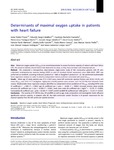Mostrar o rexistro simple do ítem
Determinants of Maximal Oxygen Uptake in Patients With Heart Failure
| dc.contributor.author | Roibal-Pravio, J. | |
| dc.contributor.author | Barge-Caballero, Eduardo | |
| dc.contributor.author | Barbeito Caamaño, Cayetana | |
| dc.contributor.author | Paniagua-Martín, María J. | |
| dc.contributor.author | Barge-Caballero, Gonzalo | |
| dc.contributor.author | Couto-Mallón, David | |
| dc.contributor.author | Pardo-Martínez, Patricia | |
| dc.contributor.author | Grille Cancela, Zulaika | |
| dc.contributor.author | Blanco-Canosa, Paula | |
| dc.contributor.author | García-Pinilla, José Manuel | |
| dc.contributor.author | Vázquez Rodríguez, José Manuel | |
| dc.contributor.author | Crespo-Leiro, María Generosa | |
| dc.date.accessioned | 2021-04-12T10:17:16Z | |
| dc.date.available | 2021-04-12T10:17:16Z | |
| dc.date.issued | 2021-03-27 | |
| dc.identifier.citation | Roibal Pravio, J., Barge Caballero, E., Barbeito Caamaño, C., Paniagua Martin, M. J., Barge Caballero, G., Couto Mallon, D., Pardo Martinez, P., Grille Cancela, Z., Blanco Canosa, P., García Pinilla, J. M., Vázquez Rodríguez, J. M., and Crespo Leiro, M. G. (2021) Determinants of maximal oxygen uptake in patients with heart failure. ESC Heart Failure, 8: 2002– 2008. https://doi.org/10.1002/ehf2.13275 | es_ES |
| dc.identifier.issn | 2055-5822 | |
| dc.identifier.uri | http://hdl.handle.net/2183/27704 | |
| dc.description.abstract | [Abstract] Aims Maximum oxygen uptake (VO₂max) is an essential parameter to assess functional capacity of patients with heart failure (HF). We aimed to identify clinical factors that determine its value, as they have not been well characterized yet. Methods We conducted a retrospective, observational, single‐centre study of 362 consecutive patients with HF who underwent cardiopulmonary exercise testing (CPET) as part of standard clinical assessment since 2009–2019. CPET was performed on treadmill, according to Bruce's protocol (n = 360) or Naughton's protocol (n = 2). We performed multivariable linear regression analyses in order to identify independent clinical predictors associated with peak VO₂max. Results Mean age of study patients was 57.3 ± 10.9 years, mean left ventricular ejection fraction was 32.8 ± 14.2%, and mean VO₂max was 19.8 ± 5.2 mL/kg/min. Eighty‐nine (24.6%) patients were women, and 114 (31.5%) had ischaemic heart disease. Multivariable linear regression analysis identified six independent clinical predictors of VO₂max, including NYHA class (B coefficient = −2.585; P < 0.001), age (B coefficient per 1 year = −0.104; P < 0.001), tricuspid annulus plane systolic excursion (B coefficient per 1 mm = +0.209; P < 0.001), body mass index (B coefficient per 1 kg/m² = −0.172; P = 0.002), haemoglobin (B coefficient per 1 g/dL = +0.418; P = 0.007) and NT‐proBNP (B coefficient per 1000 pg/mL = −0.142; P = 0.019). Conclusions The severity of HF (NYHA class, NT‐proBNP) as well as age, body composition and haemoglobin levels influence significantly exercise capacity. In patients with HF, the right ventricular systolic function is of greater importance for the physical capacity than the left ventricular systolic function. | es_ES |
| dc.description.sponsorship | This work was supported by FEDER Funds, Instituto de Salud Carlos III, Madrid | |
| dc.language.iso | eng | es_ES |
| dc.publisher | Wiley Online Library | es_ES |
| dc.relation.uri | https://doi.org/10.1002/ehf2.13275 | es_ES |
| dc.rights | Atribución-NoComercial-SinDerivadas 4.0 Internacional | es_ES |
| dc.rights.uri | http://creativecommons.org/licenses/by-nc-nd/4.0/ | * |
| dc.title | Determinants of Maximal Oxygen Uptake in Patients With Heart Failure | es_ES |
| dc.type | info:eu-repo/semantics/article | es_ES |
| dc.rights.access | info:eu-repo/semantics/openAccess | es_ES |
Ficheiros no ítem
Este ítem aparece na(s) seguinte(s) colección(s)
-
INIBIC-ICATC - Artigos [174]







